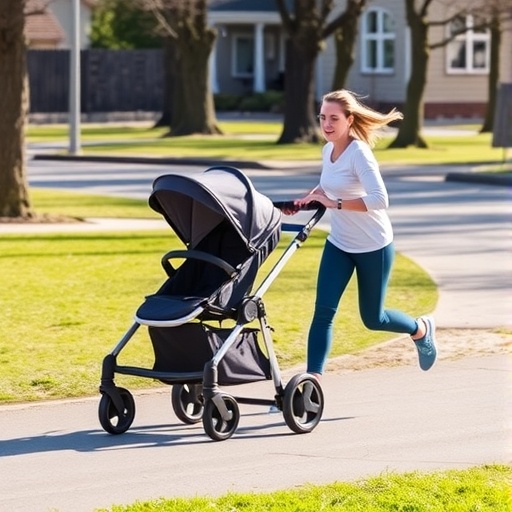In the bustling world of fitness and parenting, a novel study from Penn State Berks has illuminated the biomechanics of stroller running, revealing surprising insights into how pushing a jogging stroller alters the forces exerted on the body during a run. This research, recently published in the journal PLOS One, challenges conventional assumptions and offers a fresh perspective on injury risk and mechanical load management when running with a stroller, a common practice for parents striving to maintain fitness amid childcare responsibilities.
Stroller running intuitively seems more challenging, as runners must propel not only their own body mass but also the mass of a stroller and child, altering natural gait patterns. The Penn State Berks research team sought to quantify these effects, focusing specifically on vertical impact loading—the force transmitted upward through the body with each foot strike—and torsional forces, which involve twisting motions of the foot and leg during the push-off phase of running. These biomechanical parameters are critical because they are closely linked to common overuse injuries among runners, which affect nearly 79% annually, according to the study.
Vertical loading rates quantify how rapidly forces are applied through the musculoskeletal system during each foot strike. Excessive vertical loading has been implicated as a primary contributor to stress injuries such as tibial stress fractures, knee osteoarthritis, and plantar fasciitis. Conversely, torsional loading relates to rotational stresses experienced by the lower extremities, which can also precipitate injuries like shin splints and Achilles tendinopathy, although the relationship between torsional forces and injury is less well characterized.
Through a carefully controlled observational study, thirty-eight healthy adult runners, both male and female, who maintained a minimum weekly mileage of five miles, underwent biomechanical testing on a force plate. This device precisely measured the magnitude and velocity of forces during running strides both with and without the added burden of a jogging stroller. Compared to running without a stroller, results demonstrated a significant reduction in vertical loading metrics when participants propelled a stroller, with decreases ranging from 8% to 17%. These reductions suggest the biomechanical impact on the runner’s lower limbs is alleviated by redistributing load through the stroller.
The underlying mechanism involves the runner’s hands firmly gripping the stroller handlebars, enabling a redistribution of body weight that partially “unweights” the legs vertically. This posture allows a fraction of the gravitational force to be transferred through the arms and stroller frame instead of directly through the lower extremities, thus attenuating peak impact forces during foot strike. This finding reframes stroller running from a potentially risky activity to one that might confer protective benefits against certain impact-related injuries.
However, this alleviation of vertical loading comes with a biomechanical trade-off: an increase in torsional forces beneath the foot by over four times in some measurements. During typical running, the upper body naturally counter-rotates relative to the legs to maintain dynamic balance and minimize rotational strain on the lower limbs. However, holding onto stroller handlebars restricts this natural counter-rotation, compelling the legs and feet to compensate by generating greater twisting forces to propel the stroller forward and maintain a straight trajectory.
This compensatory mechanism may elevate torsional stresses along the ankle, tibia, and foot, potentially increasing the risk for stress-related injuries unique to this form of running. Nonetheless, the researchers emphasized that the correlation between elevated torsional loading and injury is not as definitively established as with vertical impact loading. Consequently, this trade-off invites further exploration into how stroller design or running technique modifications could mitigate these torsional stresses.
The principal investigator, Allison Altman Singles, highlighted the novelty of this study in biomechanical research, noting that while treadmill studies exist on running economy and exertion, this is among the first to explicitly quantify how loading forces alter with the introduction of a stroller. She underscored the implications for developing coaching strategies tailored for stroller runners to optimize injury prevention and rehabilitation, alongside potential innovations in stroller engineering to better accommodate biomechanical demands.
The study underscores a crucial message for the fitness community and parents: stroller running is not inherently hazardous and, in fact, may reduce some aspects of injury risk by offloading vertical impact forces. This finding can encourage greater confidence among parents seeking to reconcile parenting duties with physical activity. However, awareness of the increased torsional loading invites a more nuanced approach, beckoning further research to fully elucidate long-term injury risks and corrective methodologies.
Additional authors contributing to the paper include Joseph Mahoney, who transitioned from an associate professorship at Penn State Berks to Alvernia University, along with Benjamin Infantolino, Amy Lista, and Diego Carbajal. Support for this research was provided by both Penn State and Alvernia University, reflecting an interdisciplinary commitment to advancing knowledge at the intersection of biomechanics, kinesiology, and engineering.
As the team continues this line of inquiry, future studies aim to refine understanding of biomechanical adaptations during stroller running and their injury implications. The integration of emerging sensor technologies, enhanced motion capture, and computational modeling may soon enable bespoke running guides and stroller designs that harmonize reduced vertical impact with minimized torsional strain, enhancing safety and performance for stroller runners worldwide.
This pioneering research opens new horizons in both sports science and child-friendly fitness modalities, demonstrating how biomechanical insights translate into practical strides for parent-athletes eager to sustain healthy, active lifestyles in the early stages of parenthood without compromising their musculoskeletal wellbeing.
—
Subject of Research: People
Article Title: Biomechanical tradeoffs in stroller running: Reduced vertical impact loading and increased torsional injury risk
News Publication Date: 24-Sep-2025
Web References: http://dx.doi.org/10.1371/journal.pone.0332616
References: PLOS One journal article, DOI 10.1371/journal.pone.0332616
Keywords: Physical exercise, Biomechanics, Human locomotion, Adults, Repetitive stress injuries, Kinetics




